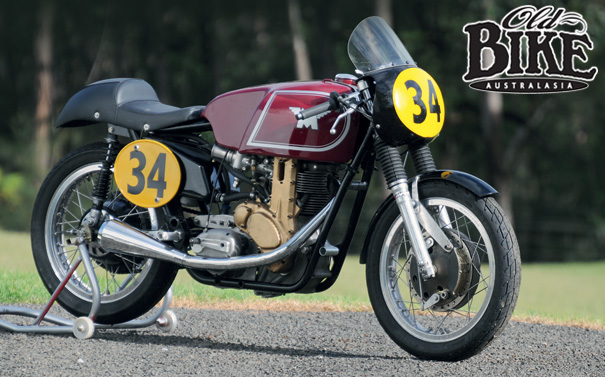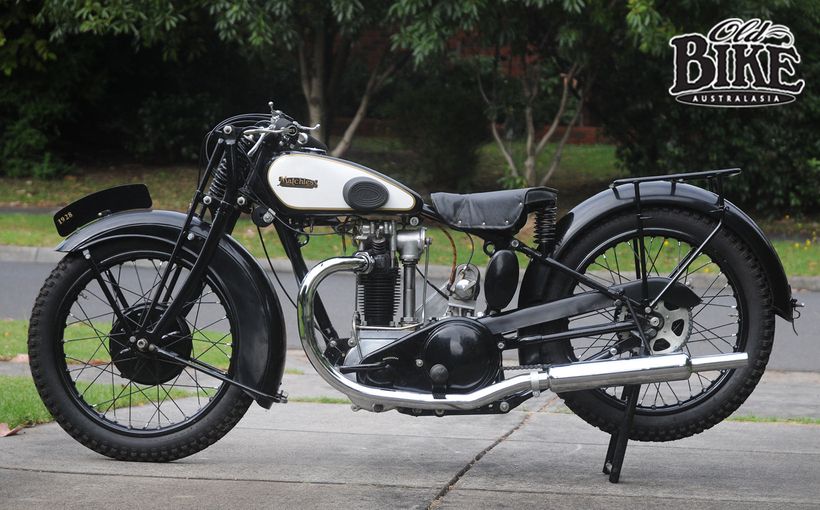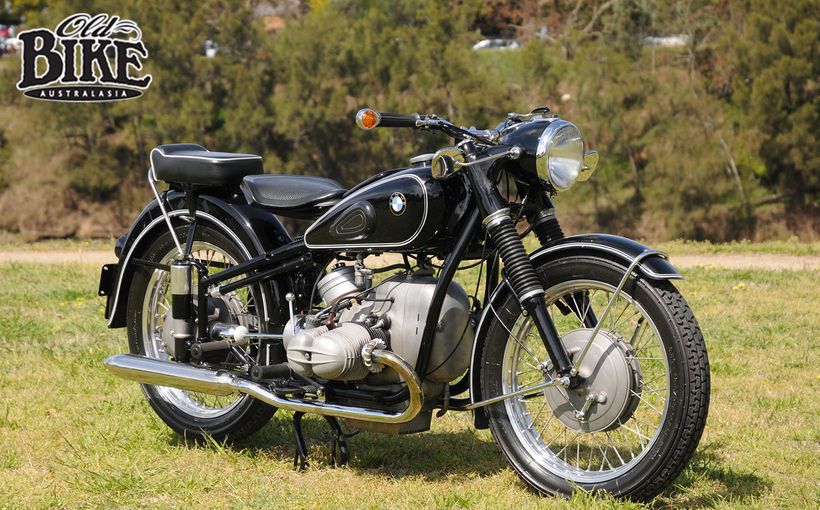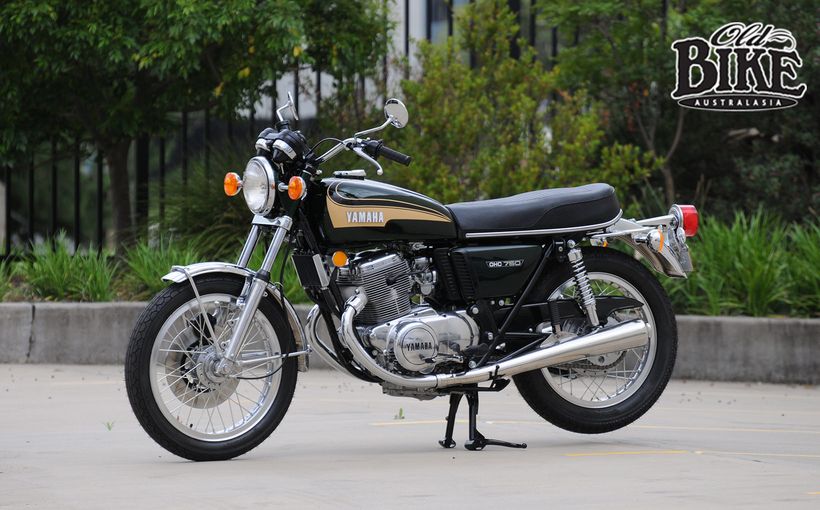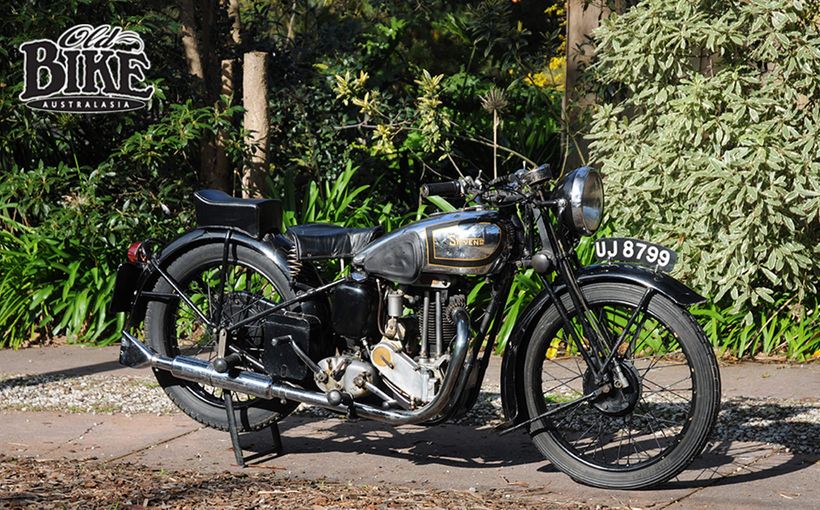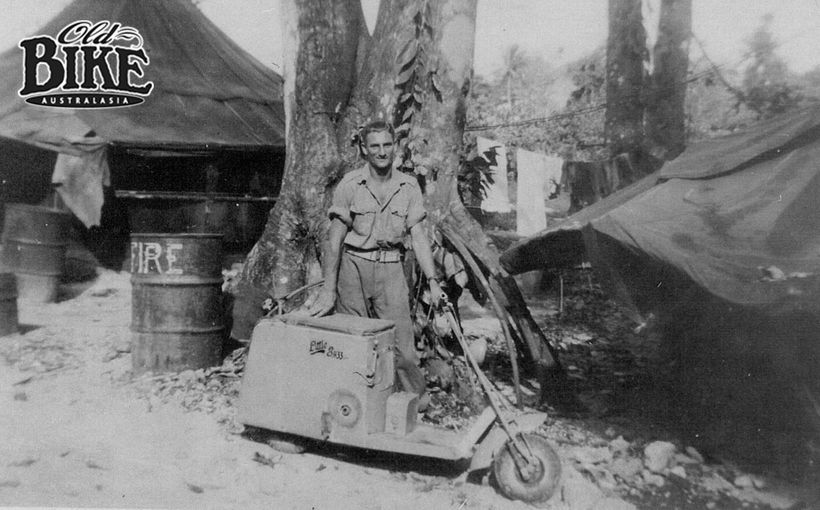Old Bike Australasia: Matchless G50 - Better late than never

The venue was the 1958 Isle of Man TT, and Jack has mixed emotions of that historic week. “It wasn’t my favourite motorbike,” Jack says with some conviction. “I think they (AMC) wanted people to know they were going to start making a 500, so it had a big red tank with Matchless on it, but it really was just a 7R bored out with a big heavy piston. With the really tall gearing for the TT it only fired about every second lamppost, and that was no good for the gearbox so that gave up. But later on, the G50 became pretty good, maybe even better than the 500 Manx.”
Perennial privateer Jack, always a Norton man, had a change of direction for the 1958 European season. “After winning Bathurst at Easter I thought that might be good enough to get a works ride, so I wrote to Jock West at AJS and he said ‘Yes, come over, we’ll give you something’. When I got there (to the AMC factory in London), he presented me with a 7R – last year’s experimental model that had been left lying around in the factory. I had to buy a fairing and do a lot of work on it, but it was hopeless, I could have run faster. I was about to give it up but they said ‘you can ride our new G50 at the TT along with the 7R’. I had ordered a new 500 Norton so I sold that to a New Zealander and waited at the TT for this new G50. Then, at the beginning of practice week, AMC’s head designer Jack Williams arrived with a machine with a red petrol tank emblazoned with the flying M of Matchless.” Ahearn’s entry for the Senior TT was changed from Norton to Matchless accordingly. It was listed as a Matchless 496 cc and sported a big capacity fuel tank from the G45, but painted red instead of the usual black and silver. The engine of Jack’s G50 was some way from what appeared later in the year as the production G50, and was limited to 7,000 rpm.

Just what was inside that engine, or its exact capacity, is still unknown, but it used 7R valves and most likely had a capacity of around 400 cc. “It was slower than the 7R”, says Jack with perhaps a touch of exaggeration. “In the race it gradually lost the gears until there was only top gear left on the last lap. I just dragged it around and finished about last.” Not quite. Stuck in top gear or not, Jack must have been going quicker than he remembers, because he came home in 29th place at an average of 88.71 mph – good enough for a Silver Replica. His last (seventh) lap at 27 minutes 43.6 was more than two minutes slower than the other six, dropping him out of the top 20. In fact, the gearbox problem had been most likely caused by the primary chain oiler packing up – the chain was bone dry and breaking up, and Jack coasted over the line with a silent engine. Nevertheless, the saga of the Matchless G50 had been born. After the TT, the AMC mechanics rebuilt the gearbox and Jack took the G50 to Europe for the Dutch TT (11th), a non-finish at the German GP, 13th in Sweden and 12th in the Ulster GP –not the kind of results he had been hoping for. “I really wasted that whole (1958) year and ended up broke. I don’t know how I got home to Australia”. Somewhat downcast after his poor season, Jack abandoned his last scheduled appearance on the G50, at the Scarborough ‘International’ meeting in September 1958, and the ride was taken over by compatriot Harry Hinton Junior. And he made the most of it, besting Bob McIntyre in a thrilling duel for third place in the 500 cc Final won by George Catlin from Bob Anderson. The following week at the season-ending Mallory Park meeting, Hinton crashed his 7R in practice and broke a collarbone and the G50 ride was taken over by John Holder, who finished sixth in the main 500 cc Challenge Trophy.

“Just a bored out 7R” it may have been, but the promise was clearly there. In fact, it was not uncommon for 7Rs to be enlarged by private owners, particularly after the bore and stroke was revised in 1956. Originally, the engine’s dimensions were 74 x 81 mm – identical to a Mk 8 KTT Velocette, but this was changed in 1956 to 75.5 x 78 mm. The simple expedient of fitting the larger bore top end to the longer stroke bottom end produced 362 cc, giving the owner a Senior class mount, which, on occasion, just happened to find its way onto the grid for the 350 race as well!
Harking back to the beginning, the post-war 7R that made its debut at a grass track meeting at Brands Hatch on 4th March 1948, the hands of AMC’s Sales Director (and former racer) Jock West had little in common with its pre-war namesake, the R7 and, in 1938 and 1939, the 7R, other than the use of the chain-driven single overhead camshaft with a Weller tensioner for the chain. The 7R was squarely aimed at the privateer and had been designed to be simple to maintain, and reliable. The engine made considerable use of Elektron which is 37.5% lighter than aluminium in any given mass – the crankcases, inner and outer timing covers, and both hubs using the exotic material. Power output on the low-octane ‘pool’ petrol of the day was quoted as 29 bhp at 6,800 rpm. The original 7R frame had its origins in the twin cylinder E90 ‘Porcupine’, with a wide double cradle in welded steel tubing that included oval sections.
Production began immediately, with the aim of having the new model on the grid for the TT in June. Priced at £255 (plus the dreaded purchase tax of £68/17/- for UK residents), the 7R was an immediate hit, and 77 complete machines were produced in 1948. The very first production 7R went to Scottish rider Fergus Anderson, who raced it on the Continent and brought it to Australia (along with two Moto Guzzis) just before Christmas. One of the first 7Rs went to Australia’s Isle of Man representative, Eric McPherson, courtesy of his connections with NSW AJS importer P&R Williams. Eric was the first Australian to compete in the TT post-war, but it was no fairytale debut, as he crashed at low speed in practice and injured his back, making him a nonstarter for the races. However the 7R came back to Australia with him and was eventually sold – to none other than Jack Ahearn.
It seemed reasonable to assume that AMC would eventually produce an enlarged 7R to give riders a Senior class mount, but in another curious move, they chose to go with a 500 based not on the proven OHC single, but the fairly unimpressive G9 pushrod twin. This became known as the G45, and achieved few real successes, while displaying a tendency to break valve gear under the strain of racing revs. Meanwhile the 7R was steadily refined, receiving a new, slimmer frame in 1954 and the shorter stroke engine two years later. The following year AMC finally diced the cumbersome Burman gearbox in favour of the Norton-derived AMC close ratio box. With continued development work by Jack Williams, the 7R had become a very competitive package, as demonstrated by men like Bob McIntyre, Mike Hailwood and Alan Shepherd.
And so by 1958, with the G45 clearly well past its use-by date and out of favour with the private owners who had to foot the bills, the clamour for a big 7R was deafening. The greatest drawback in obtaining a full 500 cc capacity was the limit of the bore size available using the standard 7R crankcases. The positioning of the through-bolts joining the cylinder head and barrel to the cases limited the maximum bore to around 86 mm, but by slightly repositioning the hole centres, a larger sleeve with a 90 mm bore was possible. Just why this should have taken so long is systematic of the torpor afflicting the entire British motorcycle industry and the tight-fisted AMC board in particular.
But eventually it did happen. At the Earls Court Show in November 1959, perched high on the Matchless stand was the new production Matchless G50, priced at £430/7/9 (£12 dearer than the 7R) with orders taken for the 1959 season. A couple of months prior to this, world champion John Surtees and journalist Bruce Main-Smith had tested the prototype G50 and a second version at Brands Hatch, accompanied by Jack Williams and works mechanics. The G50 ridden by Jack Ahearn in the TT still had the earlier frame, with a wider engine cradle that had shown a tendency to scrape the bottom frame rails under hard cornering, while on the second, newer machine, the frame cradle had been narrowed, the engine repositioned slightly higher in the frame, and the exhaust pipe tucked in closer. Two weeks later, Scot Bob McIntyre had a run at Silverstone, testing new Avon tyres with a view to racing a G50 in 1959.
The 1959 TT included two new events, dubbed Formula One, in both Junior and Senior categories, which excluded works bikes and should have been custom made for the G50. But the leading men stuck with their Nortons, and only one Matchless made it home in the top 15 in the Senior, that of Derek Powell in 7th place. It was a happier story in the Junior Formula One with Scot Alistair king winning on a 7R. In the wet Senior TT, Powell improved to 4th place on his G50, behind the Works MV Agusta of John Surtees and the Nortons of Alistair King and Bob Brown. Also riding G50s, Alan Shepherd and George Catlin finished 7th and 8th respectively.
Gradually the G50 found favour amongst the privateers, the ease of maintenance, oil tight motor and lower running costs compared to a Manx appealing to many, even if the Matchless was still a couple of horsepower shy of the Norton. On some of the tighter English tracks the G50 was reckoned to be a better tool than the Manx, due to the flexibility of the engine. Production for 1960, 1961 and 1962 was around 40 complete units per year, and for the 1962 production year, the G50 had received a small makeover, with the inlet valve increased in size by 1/8 inch to 2 inches, and the outer timing chest modified to allow the exhaust pipe to be tucked in closer. But in early 1963 came the bombshell from AMC that there would be no more racers; an announcement that sounded the death knell for the 7R and Manx Norton as well. At the close of play, only 180 complete G50s had been produced. It was a bitter blow for road racing the world over, which was already deeply affected by the downturn in motorcycle sales that was to continue for several more years. There were in fact, G50s of a sort made in 1963 – 25 machines called Matchless CSR (or Golden Eagle in the USA) produced for the US market with G50 engines in the road-going CSR chassis to comply with AMA requirements whereby racing machinery had to be based on street bikes. The demise of the British production racers had the effect of giving birth to a cottage industry to keep existing machines running. In the case of the G50 and 7R, salvation came in the form of sidecar racer Colin Seeley, who had campaigned a G50- engine outfit with considerable success. After making lightweight frames to take G50 and 7R engines for a couple of years, Seeley took the plunge in 1966 and bought out the remains of the AMC Racing Department, along with the tooling and manufacturing rights for the engines and spares. The move prolonged the life of the venerable singles for several years (and gave birth to the G50-engined Seeley Condor road bike), but for the purists, and the record, the last real G50 had unceremoniously gone out the doors of the AMC factory in Plumstead Road, Woolwich, in the early weeks of 1963.

The G50 resurrection
The advent of Historic Racing in the mid 1970s meant a new lease of life for the old British bangers – bikes that had been consigned to the shed since being chased off the tracks by the new wave of Japanese two strokes. Some of the original riders were still around to give their old steeds a few airings too, but the rigours of competition soon began to show the natural atrophy that seems to occur with racing iron. For the G50, the original magnesium crankcases have a definite shelf life before becoming brittle and cracking, and aluminium replacements are not exactly thick on the ground. Certain components – conrods from Carillo, pistons from Mahle, valves sourced from other makes and so on – meant that the original engines could continue to run, if not race hard.
By the mid-1980s, Historic racing was booming and an industry had sprung up to supply parts, and eventually complete Manx Nortons and Matchless G50s. In the case of the latter, cylinder heads made by Mick Rutter in the UK were the first major component manufactured, but soon complete engines were available from several sources, including Germany. Noted collector George Beale began offering complete bikes, in original specification as well as a special lightweight version designed for the International Historic Racing Organisation, which these days runs major historic events at traditional road circuits like Chimay and Mettet in Belgium and Schleiz in Germany. If you have a well-fettled G50, there’s no shortage of events in Europe.
I had such a machine, which I owned for 25 years. It came into my possession in 1982, when I was invited to the Mike Hailwood Tribute at Donington Park in England. The bike I was supposed to have ridden did not eventuate, but George Beale just happened to have a nice looking G50 for sale, so… After changing the 20-year-old tyres for something a little more supple, I had a most enjoyable day in the two Tribute sessions, ‘dicing’ (not racing) with the great British all-round racer Ron Langston on his G50. My newly-acquired machine was subsequently shipped back home in time for the annual January Long Weekend meeting at Amaroo Park, where I unfortunately came a cropper when the rear brake torque arm broke and dug into the track. The bike was a bit bent, so it was stripped and the frame dispatched to Peter Campbell in Goulburn, who discovered some earlier fiendish work had been performed on the bottom frame rails. Being the master craftsman that he is, Peter soon had the chassis better than new, and I raced the G50 on and off for the next 20 years. It was reliable and quick; some highlights being three wins at the annual Easter Bathurst Historic race held within the main program and first in the Historic class at the Australian TT held on a once-only street circuit at Port Kembla near Wollongong in 1996.
Then, during the process of building a new house with the associated cost over-runs, the G50 was sold – something that I rued from the day it left my possession. In 2009, with a watchful eye on the exchange rate between the Australian dollar and the British Pound, temptation got the better of me and I purchased a brand new G50 engine, complete with magneto, from Mick Taberer in England. Mick’s engines, while remaining faithful to the original concept, have subtle and worthwhile internal mods. The bottom end incorporates what probably should have been done in the first place. Instead of pressed-up crankshaft halves, each flywheel and its shaft is a one-piece forging in EN36, ground and hardened. The drive side main bearing is needle roller with an external seal, with a ball and roller bearing on the timing side. A forged Omega piston sits atop the forged conrod.
This, I told myself, was to be a long-term project, to be tackled when time and finances permitted. And of course, an engine is only part of the story, admittedly a major part. The next temptation presented itself during the 2010 Classic Festival at Pukekohe when I was discussing my new ‘project’ with Peter Lodge, the Auckland engineer who built the astoundinglyrapid pushrod ES2-based Norton ridden with much success by Sam Smith and the late Paul Dobbs. At one stage Peter had an idea to build a G50 and had got as far as constructing a jig and making a complete frame, but as he had abandoned the idea, the frame was now surplus to requirements. Dollars were exchanged and another part was in place. Peter had not gone as far as making the swinging arm, but had it all drawn up and with a factory full of the latest CNC machinery, the various lugs and fittings were produced. The G50 swinging arm uses tapered tubing, and in the interests of originality, so did Peter, turning the tapered tube from solid before bending it into shape. The rear hub came from Molnar Precision Engineering in England, along with the fork yokes, seat and ancillary fittings. Also from England (while the exchange rate held out) came a brand new 1 1/2” Amal GP carburettor. This was supplied by Burlen Fuel Systems in Salisbury, who now produce a big range of Amal products, as well as SU and Zenith carbs and parts.
A genuine petrol tank was sourced from the estate of the late Allen Burt, but the oil tank needed to be made, and who better to do so than master tin-basher Steve Roberts from Wanganui, NZ, the man who built the superb monocoque Suzuki TT F1 racer campaigned in Europe by Dave Hiscock. Ross Graham from New Plymouth, NZ, owner of the fleet of 7Rs and G50s raced with outstanding success by Dave Cole, supplied a genuine oil tank as a pattern and Steve soon had a beautiful exact replica created. Ross also found he had a set of original G50 Girling rear shock absorbers in his workshop, so these were fitted in the interests of originality.
A gearbox was no problem, since ex-South African Bruce Verdon builds complete AMC racing boxes at his TT Industries base in Nelson, NZ. These are available in 4,5 or 6 speed, with either magnesium or aluminium casings. I chose a 5-speeder in aluminium, simply because it looks more correct when compared to the originals. Bruce has recently started making his own clutches, loosely based on the Norton Commando design with a toothed-belt primary drive, so that’s the transmission sorted.
Basically this just left the front end, which was put together by Martyn Adams at Birdwood Motorcycle Engineering in South Australia, using AMC/Matchless sliders with Spanish bettor tubes and internal damping mechanism. I have never been a huge fan of the 7R/G50 front brake, and because the Period 3 regulations allowed it, I opted for an Italian Oldani 230 mm magnesium twin leading shoe job, which came from Motocicli Veloci in Italy, a reproduction of the brake used by Mike Hailwood on his Norton to win the 1961 Senior TT. The fibreglass nose cone was one of the last jobs produced by Brian Crane before Homebush Fibreglass closed its doors after 40-odd years and countless Norton fairings, and into this went a replica Manx/7R conical tacho built by Dennis Quinlan.
So that’s now a big pile of parts, and the man to put them together was obviously Peter Campbell, so off we went to deliver the lot to Goulburn. Peter made the engine plates, footrests, rear brake pedal, gear lever, float bowl mount, rear axle, front brake stay and various other fittings. Rod Tingate, another master craftsman from Melbourne, made the clip-on handlebars. From a leisurely project, the completion date was now firmly drawn in the sand in order to make the Australian Historic Racing Championships at Phillip Island in September 2010. And we made it, just. That weekend, Victoria was lashed with evil weather, and naturally the Island copped its share, making it most unsuitable for sorting out a brand new motorcycle. Yes, there were teething problems, but nothing massive, the most obvious being the front brake’s rather disappointing stopping power. This was addressed with a set of new 2520V linings from Vintage Brake in California. These were machined to exact tolerances by Doug Fraser from EMU Engineering in Melbourne, the man who has hand-built the amazing Empire Twins that have been extensively featured in OBA. Subsequent hours in the workshop had the G50 rather better sorted for its next appearance at the 2011 Barry Sheene Memorial at Eastern Creek. In a short track session prior to the event, the front forks still seemed to lack proper damping, so a set of US-made Gold Valves went in, with a much-improved movement as a result. As nice and original as the rear shocks looked, the damping had certainly seen better days, so, using the unique AMC-only clevis-mount bottom mounts which simply unscrew from the Girling body, a new set of Australian-made Ikon (formerly Koni) dampers and springs were fitted. I am still on the hunt for a set of chrome top covers and after these are fitted – from a distance at least – the units will look passably original.

The G50’s third run came at the recent (Easter 2011) Honda Broadford Bike Bonanza. With four other bikes to ride I was more than happy to hand the G50 over to 4-times World Champion Hugh Anderson, who galloped it at a fair lick and looked just like he did nearly 30 years ago when he raced his own G50 in the early IHRO events in Europe. This time the bike came back with a clean report card. Job done.
As well as the aforementioned people, a big thank you must also go to Geoff Clatworthy and Tony Henderson for much help and advice, Lance Roper from Cablemate in Hobart who made all the cables, Ron Keed in Sydney for the paintwork, Ian Hopkins who loaned an exhaust pipe and megaphone for Phillip Island, Chris Squires who laced up both wheels, and Bob Howle who bent up the new exhaust pipe.
Once again, it’s nice to have a G50 in the garage – to my eye, one of the most glorious looking racing motorcycles ever built. And even if this one didn’t come out of Plumstead Road, Woolwich, and the majority of the components came from New Zealand and Australia, it has been built to visually replica the original exactly. And if it looks like a G50, sounds like a G50 and goes like a G50, it must be a G50.
Protect your Matchless. Call Shannons Insurance on 13 46 46 to get a quote today.

